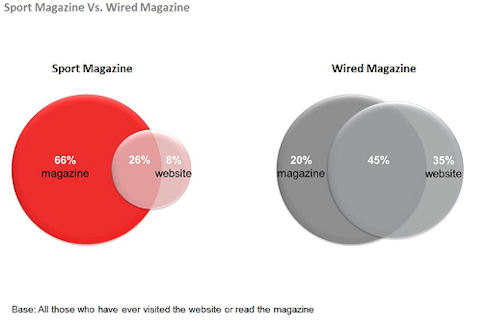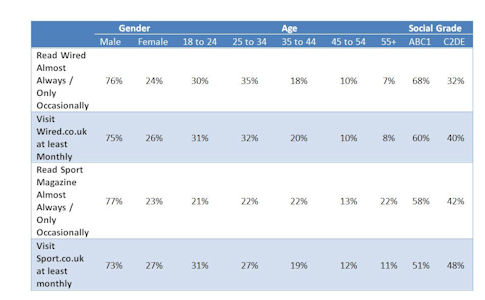The popularity of the internet has seen demand for content reach unprecedented levels. And as belts tighten, more people are deciding to read free content online rather than pay for publications.
Research firm YouGov has investigated this trend further by looking at data collected from its panel to understand in more detail who is accessing content online and who is reading physical printed copies of publications. Shaun Austin, associate director in the YouGov media team, explains: “The objective was to understand how the profile of those accessing content online differs from those who read the physical copies of the magazine. The survey was completed by around 60,000 YouGov panel members with results extrapolated and analysed at a nationally representative sample level of 14,000 respondents.”
How readers access printed and online magazines

Source: YouGov
Not surprisingly, magazines aimed at techies, such as Wired, attract a larger online audience. Austin suggests additional reasons why Wired is successful online: “Wired magazine has devoted a lot of time and money towards its online and digital propositions, and as indicated by the chart below, this appears to have paid off with large proportions of its audience accessing the content in multiple ways.“
Magazines that just replicate their printed editions online, such as Sport magazine, have a smaller proportion of their audience reading them digitally. But as Austin points out, as the magazine is mainly distributed by hand, having an online version is useful for readers who can‘t get hold of a printed copy. As Sport magazine is a free publication, there is no cost saving for readers who choose to read it online.
Looking at the difference between readers of Sport magazine, compared with those of Wired, Austin says: “The chart below shows that of those who access content from Sport magazine, 66 per cent read only the physical printed publication, 8 per cent only look at the website, while 26 per cent read both the printed publication and visit the website. For those who access content from Wired magazine, we see an audience who is much more engaged with the online content and that there is a strong online and print offering. Of those who access content from Wired, 20 per cent do so through reading the printed magazine, while 33 per cent only access content from the website and 45 per cent access content from both the website and read the magazine.”
![]()
Comparing the profile of those who regularly visit the website and read the magazine shows the demographics of both audiences are quite similar, however it appears a slightly more affluent audience buys printed copies compared to those visiting the website. Of those who regularly visit Sport.co.uk, a higher proportion of them are aged 18 to 34 (58 per cent) compared to those who read the physical magazine (43 per cent).
Assessing content habits by demographic type table

Source: YouGov
So what does this mean for the PR profession? Austin suggests that when PR professionals place content in publications they should not only think about the target audience of the publication, but also the platform upon which the article is appearing. He adds: “They should look at whether the demographics for that platform deviates from or enhances reaching the desired target audiences. Importantly, if the publication has multiple platforms then the content will attract incremental readership. Therefore, as long as the audiences of each platform are in line with the target audience of your campaign then the content should be placed on as many platforms as possible to reach the largest target audience possible.”
Background
All figures, unless otherwise stated are from YouGov. Total sample size was 14,000 nationally representative respondents of Great Britain. Fieldwork was undertaken between 16 May and 6 June 2011. The survey was carried out online.
PR Masterclass: The Intersection of PR and GEO
Join PRmoment for a Masterclass featuring 10 of the industry’s foremost experts. You will walk away with a clear, actionable strategy for adapting your content to an AI-first search environment.
Taking place on Wednesday 25th February in London, both virtual and in person tickets are available.
Early bird ticket sale ends Friday 9 January.
PR MasterclassIf you enjoyed this article, sign up for free to our twice weekly editorial alert.
We have six email alerts in total - covering ESG, internal comms, PR jobs and events. Enter your email address below to find out more:









